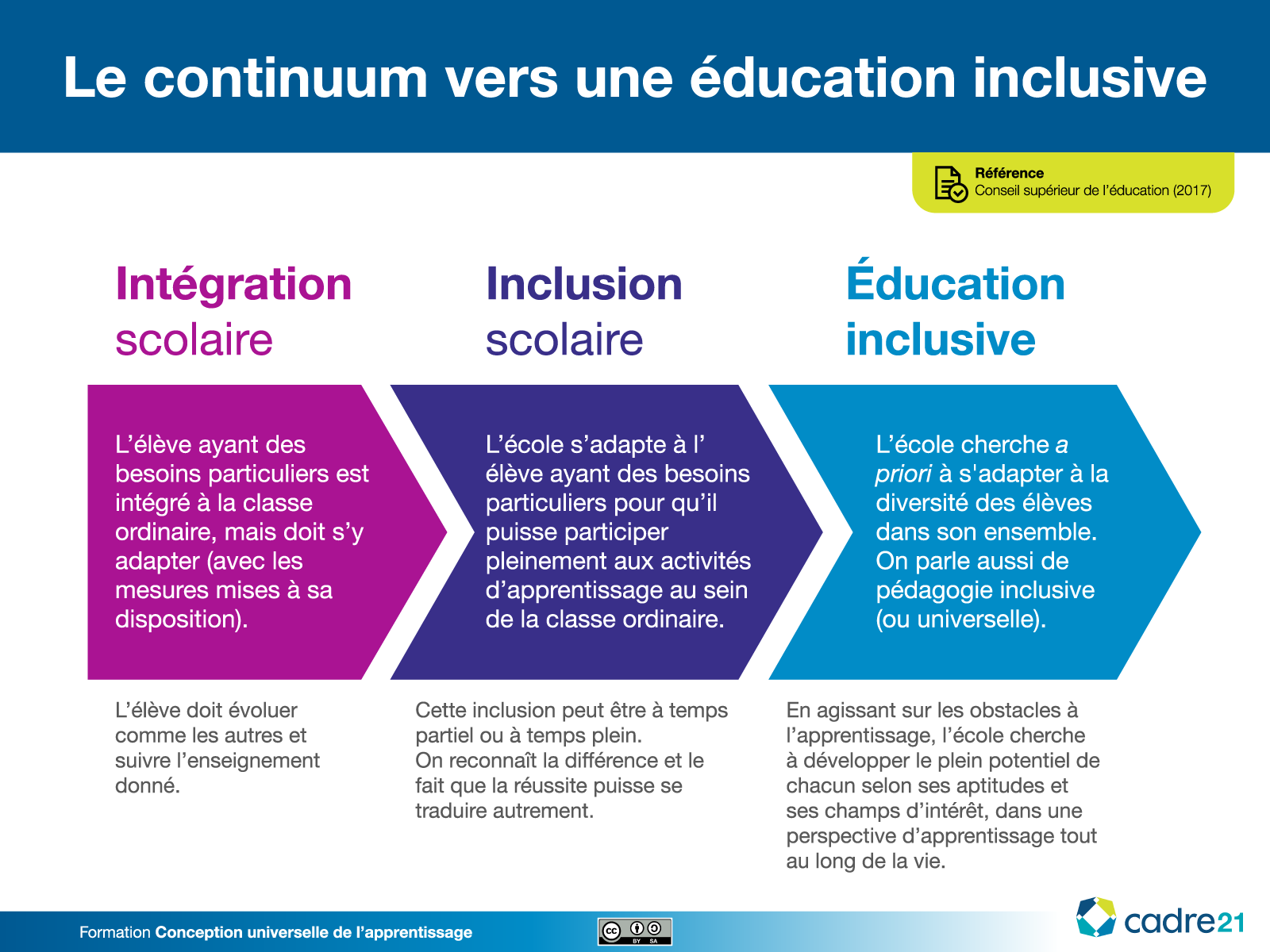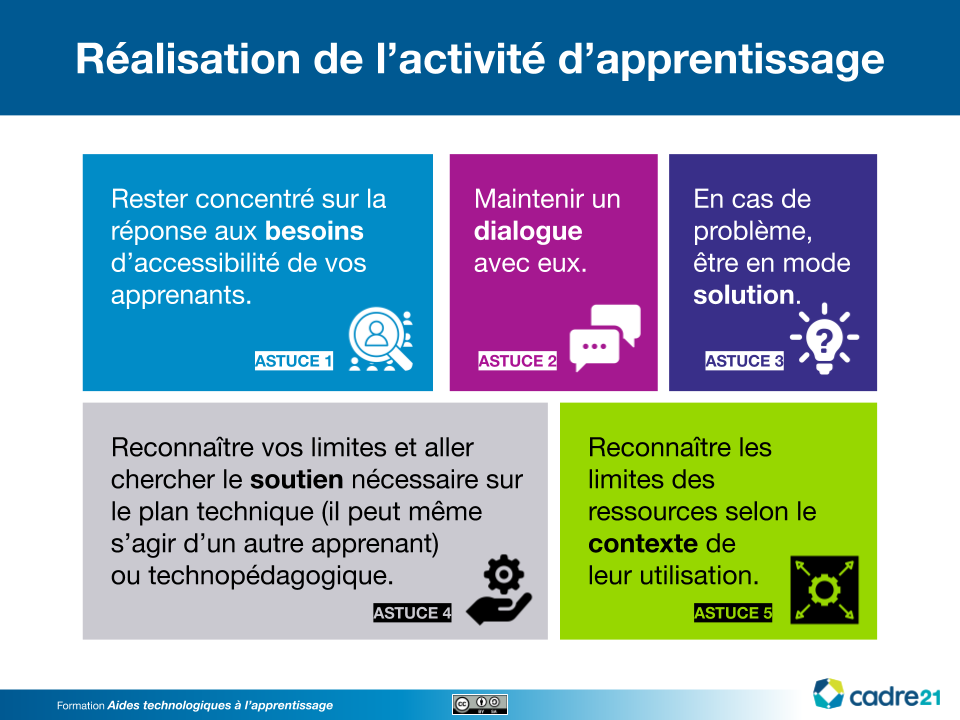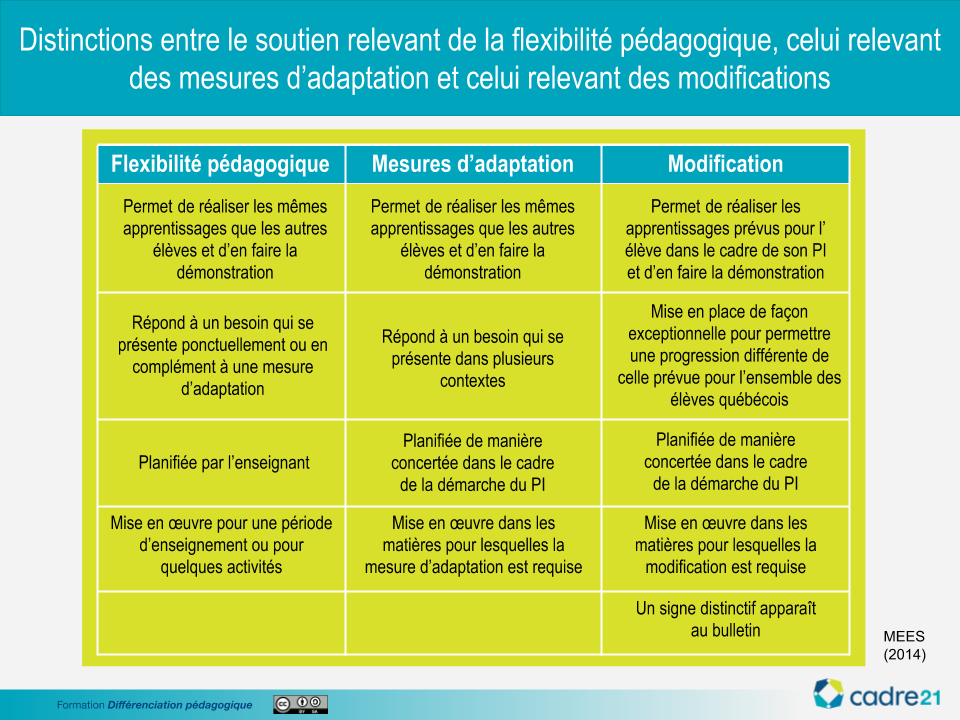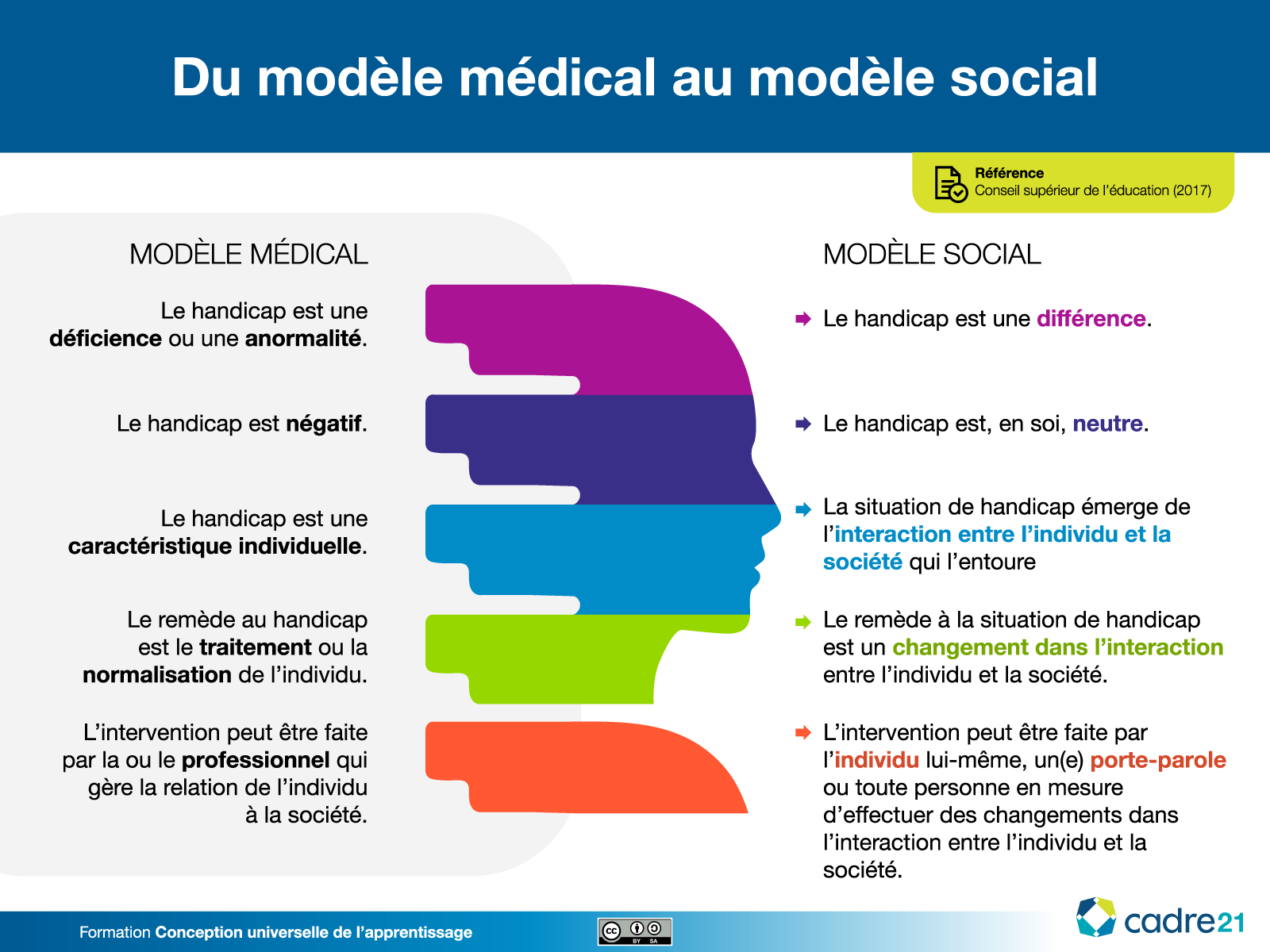Par Marie-Noëlle Marineau, gestionnaire de communauté et chargée de projets au CADRE21
Adopter une posture pédagogique qui tient réellement compte de la diversité des personnes apprenantes peut sembler être un objectif inatteignable. Dans le contexte d’une année scolaire déjà bien remplie où le temps pour éplucher les récentes études sur le sujet est difficile à trouver, il faut rester réaliste et voir le défi comme un marathon plutôt qu’un sprint.
Dans les faits, la création d’un contexte dans lequel une personne apprenante peut vivre une expérience d’apprentissage positive, enrichissante et motivante est possible et probablement plus simple que vous le croyez.
Dans son rapport de 2017 sur l’éducation inclusive, le Conseil supérieur de l’éducation (CSE) présente un continuum vers une école inclusive pour tous les élèves. On y retrouve l’intégration scolaire, l’inclusion scolaire et l’éducation inclusive.

Le CSE soulève que les différents milieux scolaires québécois se situent sur ce continuum, mais que malgré les efforts, l’objectif de conduire chaque personne apprenante vers sa réussite est encore inachevé. Pour améliorer l’inclusivité de votre milieu scolaire, voici quelques concepts de base à apprivoiser (ou revoir) dès maintenant.
1- Connaître les particularités des apprenants et apprenantes
Savoir reconnaître certains troubles d’apprentissage chez les personnes apprenantes permet d’adapter l’enseignement en pratiquant la différenciation pédagogique (voir le point suivant) afin que chacune d’entre elles puisse s’épanouir et atteindre sa pleine capacité. Il en va de même pour les profils dits « neuroatypiques » comme les personnes autistes, celles qui ont un trouble du déficit de l’attention ou les apprenants et apprenantes à haut potentiel.
Pour plusieurs, l’accès à des aides technologiques à l’apprentissage (technologies d’assistance) peut réduire ou éliminer les obstacles qui se dressent entre eux et les tâches à réaliser. Dans ce cas, il faut s’assurer de la combinaison harmonieuse entre les ressources éducatives numériques accessibles, les appareils utilisés par les apprenants et apprenantes en classe et l’utilisation des aides technologiques pour les personnes ayant des besoins particuliers.

2- S’initier à la différenciation pédagogique
La différenciation pédagogique est une approche qui combine plusieurs stratégies pour accompagner les personnes apprenantes vers l’atteinte de leur plein potentiel.
On en retrouve trois formes : la flexibilité pédagogique, l’adaptation (ou ajustement) et la modification.
- La flexibilité pédagogique est cette souplesse où l’enseignant propose des choix planifiés à tous ses élèves lors de séquences d’enseignement et d’apprentissage.
- L’adaptation représente les ajustements à ces séquences d’enseignement et d’apprentissage, mais ne vient pas modifier ce qui est évalué.
- La modification fait référence à des changements qui modulent les séquences d’enseignement et d’apprentissage et qui touchent les critères d’évaluation et les attentes de la situation d’évaluation. En contexte de modification, le niveau de difficulté des situations est modifié.
« La différenciation n’est pas une banque de stratégies, mais plutôt une façon de réfléchir à l’enseignement et à l’apprentissage. »
– Carol Ann Tomlinson, pionnière en différenciation pédagogique

3- Apprendre les rudiments de la conception universelle de l’apprentissage
La conception universelle de l’apprentissage (CUA) vise à développer des personnes apprenantes :
- débrouillardes, bien informées et compétentes (en leur offrant plusieurs moyens de représentation);
- centrées sur les objectifs stratégiques (en leur offrant plusieurs moyens d’action et d’expression);
- motivées et déterminées (en leur offrant plusieurs moyens d’engagement).
Cette approche inclusive tend à mettre en place des façons de faire pour respecter la diversité des personnes apprenantes tout en tenant compte de leurs besoins. Elle s’appuie sur le modèle social du handicap qui affirme que les personnes handicapées sont désavantagées par les barrières externes et environnementales qui leur sont imposées.

4- Créer un environnement d’apprentissage capacitant
Étroitement lié à la CUA, l’environnement capacitant favorise une expérience apprenante positive. Ses origines sont issues de l’approche par capacités (capabilité) de l’économiste Amartya Sen (Fernagu Oudet, 2012). Selon lui, les capacités diffèrent des capabilités puisque les premières relèvent d’un savoir-faire et les secondes, du pouvoir faire. L’environnement capacitant permet aux apprenants de développer leur autonomie leur offrant la liberté de faire des choix, de prendre des actions et de réfléchir pour démontrer leurs « capacités » dans leurs réalisations.
Alors que l’individualisation des mesures d’aide peut alourdir la tâche des ressources enseignantes (et de l’ensemble des actrices et acteurs des milieux éducatifs), la mise en place d’une éducation inclusive vient assurer de meilleures chances de réussite pour tous sans épuiser les ressources.
Un milieu ne devient pas inclusif du jour au lendemain, mais des efforts collectifs en ce sens favorisent un apprentissage optimal pour tous.
Pour aller plus loin
Les autoformations du CADRE21 en lien avec les sujets abordés :
- Autoformation sur la différenciation pédagogique
- Autoformation sur la conception universelle de l’apprentissage
- Autoformation pour soutenir l’apprenant ayant un trouble dys
- Autoformation pour engager l’apprenant à haut potentiel
- Autoformation pour découvrir les aides technologiques à l’apprentissage
- Autoformation sur l’expérience apprenante en FAD
D’autres lectures intéressantes sur le sujet :
- De l’intégration à l’inclusion scolaire des élèves en difficulté d’adaptation et d’apprentissage
- Éducation inclusive : repères pour la pratique à l’université
- Jour 7 de l’Expédition Québec – Finlande : l’éducation inclusive finlandaise
- Pour une école riche de tous ses élèves – S’adapter à la diversité des élèves, de la maternelle à la 5e année du secondaire
- L’inclusion; oui, mais comment?
Le numéro du printemps 2023 du magazine de l’École branchée aura pour thème l’éducation inclusive : La cohabitation des diversités. Abonnez-vous avant le 31 mars 2023 pour le recevoir.




 Recevez l'Info #DevProf et l'Hebdo pour ne rien manquer des nouveautés de l'École branchée!
Recevez l'Info #DevProf et l'Hebdo pour ne rien manquer des nouveautés de l'École branchée!




